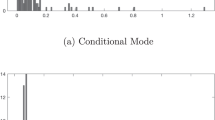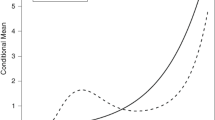Abstract
Consider a stochastic frontier model with one-sided inefficiency u, and suppose that the scale of u depends on some variables (firm characteristics) z. A “one-step” model specifies both the stochastic frontier and the way in which u depends on z, and can be estimated in a single step, for example by maximum likelihood. This is in contrast to a “two-step” procedure, where the first step is to estimate a standard stochastic frontier model, and the second step is to estimate the relationship between (estimated) u and z.
In this paper we propose a class of one-step models based on the “scaling property” that u equals a function of z times a one-sided error u * whose distribution does not depend on z. We explain theoretically why two-step procedures are biased, and we present Monte Carlo evidence showing that the bias can be very severe. This evidence argues strongly for one-step models whenever one is interested in the effects of firm characteristics on efficiency levels.
Similar content being viewed by others
References
Battese, G. E. and T. J. Coelli. (1988). “Prediction of Firm-Level Technical Efficiencies with a Generalized Frontier Production Function and Panel Data.” Journal of Econometrics 38, 387-399.
Battese, G. E. and T. J. Coelli. (1995). “A Model for Technical Inefficiency Effects in a Stochastic Frontier Production Function for Panel Data.” Empirical Economics 20, 325-332.
Caudill, S. B. and J. M. Ford. (1993). “Biases in Frontier Estimation Due to Heteroskedasticity.” Economics Letters 41, 17-20.
Caudill, S. B., J. M. Ford and D. M. Gropper. (1995). “Frontier Estimation and Firm-Specific Inefficiency Measures in the Presence of Heteroskedasticity.” Journal of Business and Economic Statistics 13, 105-111.
Huang, C. J. and J.-T. Liu. (1994). “Estimation of a Non-Neutral Stochastic Frontier Production Function.” Journal of Productivity Analysis 5, 171-180.
Kumbhakar, S. C., S. Ghosh and J. T. McGuckin. (1991). “A Generalized Production Frontier Approach for Estimating Determinants of Inefficiency in U.S. Dairy Farms.” Journal of Business and Economic Statistics 9, 279-286.
Kumbhakar, S. C. and C. A. K. Lovell. (2000). Stochastic Frontier Analysis. Cambridge University Press.
Reifschneider, D. and R. Stevenson. (1991). “Systematic Departures from the Frontier: A Framework for the Analysis of Firm Inefficiency.” International Economic Review 32, 715-723.
Ritter, C. and L. Simar. (1997). “Pitfalls of Normal-Gamma Stochastic Frontier Models.” Journal of Productivity Analysis 8, 167-182.
Simar, L., C. A. K. Lovell and P. Vanden Eeckaut. (1994). “Stochastic Frontiers Incorporating Exogenous Influences on Efficiency.” Discussion Papers No. 9403, Institut de Statistique, Université Catholique de Louvain.
Author information
Authors and Affiliations
Rights and permissions
About this article
Cite this article
Wang, Hj., Schmidt, P. One-Step and Two-Step Estimation of the Effects of Exogenous Variables on Technical Efficiency Levels. Journal of Productivity Analysis 18, 129–144 (2002). https://doi.org/10.1023/A:1016565719882
Issue Date:
DOI: https://doi.org/10.1023/A:1016565719882




